Brealey, Myers. Principles of Corporate Finance. 7th edition
Подождите немного. Документ загружается.


Brealey−Meyers:
Principles of Corporate
Finance, Seventh Edition
IX. Financial Planning and
Short−Term Management
32. Credit Management
© The McGraw−Hill
Companies, 2003
WHEN COMPANIES SELL their products, they sometimes demand cash on or before delivery, but in most
cases they allow some delay in payment. If you turn back to the balance sheet in Table 30.1, you can
see that for the average manufacturing company, accounts receivable constitute about one-third of
its current assets. Receivables include both trade credit and consumer credit. The former is by far the
larger and will, therefore, be the main focus of this chapter.
Companies that do not pay for their purchases immediately are effectively borrowing money from
their suppliers. Such “debts” show up as accounts payable in the purchasing companies’ balance
sheets. Table 30.1 shows that payables are the most important source of short-term finance, much
larger than short-term loans from banks and other institutions.
Management of trade credit requires answers to five sets of questions:
1. On what terms do you propose to sell your goods or services? How long are you going to give
customers to pay their bills? Are you prepared to offer a cash discount for prompt payment?
2. What evidence do you need of indebtedness? Do you just ask the buyer to sign a receipt, or do
you insist on some more formal commitment?
3. Which customers are likely to pay their bills? To find out, do you consult a credit agency or ask for
a bank reference? Or do you analyze the customer’s financial statements?
4. How much credit are you prepared to extend to each customer? Do you play it safe by turning
down any doubtful prospects? Or do you accept the risk of a few bad debts as part of the cost of
building up a large regular clientele?
5. How do you collect the money when it becomes due? How do you keep track of payments? What
do you do about reluctant payers or deadbeats?
We will discuss each set of questions in turn.
909
32.1 TERMS OF SALE
Not all sales involve credit. For example, if you are producing goods to the cus-
tomer’s specification or incurring substantial delivery costs, then it may be sensi-
ble to ask for cash before delivery (CBD). If you are supplying goods to a wide
variety of irregular customers, you may prefer cash on delivery (COD).
1
If your
product is expensive and custom-designed, you may require progress payments
as work is carried out. For example, a large, extended consulting contract might
call for 30 percent payment after completion of field research, 30 percent more on
submission of a draft report, and the remaining 40 percent when the project is fi-
nally completed.
When we look at transactions that do involve credit, we find that each industry
seems to have its own particular usage with regard to payment terms.
2
These
norms have a rough logic. For example, firms selling consumer durables may al-
low the buyer a month to pay, while those selling perishable goods, such as cheese
or fresh fruit, typically demand payment in a week. Similarly, a seller will gener-
ally allow more extended payment if its customers are in low-risk businesses, if
1
Some goods can’t be sold on credit—a glass of beer, for example.
2
Standard credit terms in different industries are reported in O. K. Ng, J. K. Smith, and R. L. Smith, “Ev-
idence on the Determinants of Credit Terms Used in Interfirm Trade,” Journal of Finance 54 (June 1999),
pp. 1109–1129.
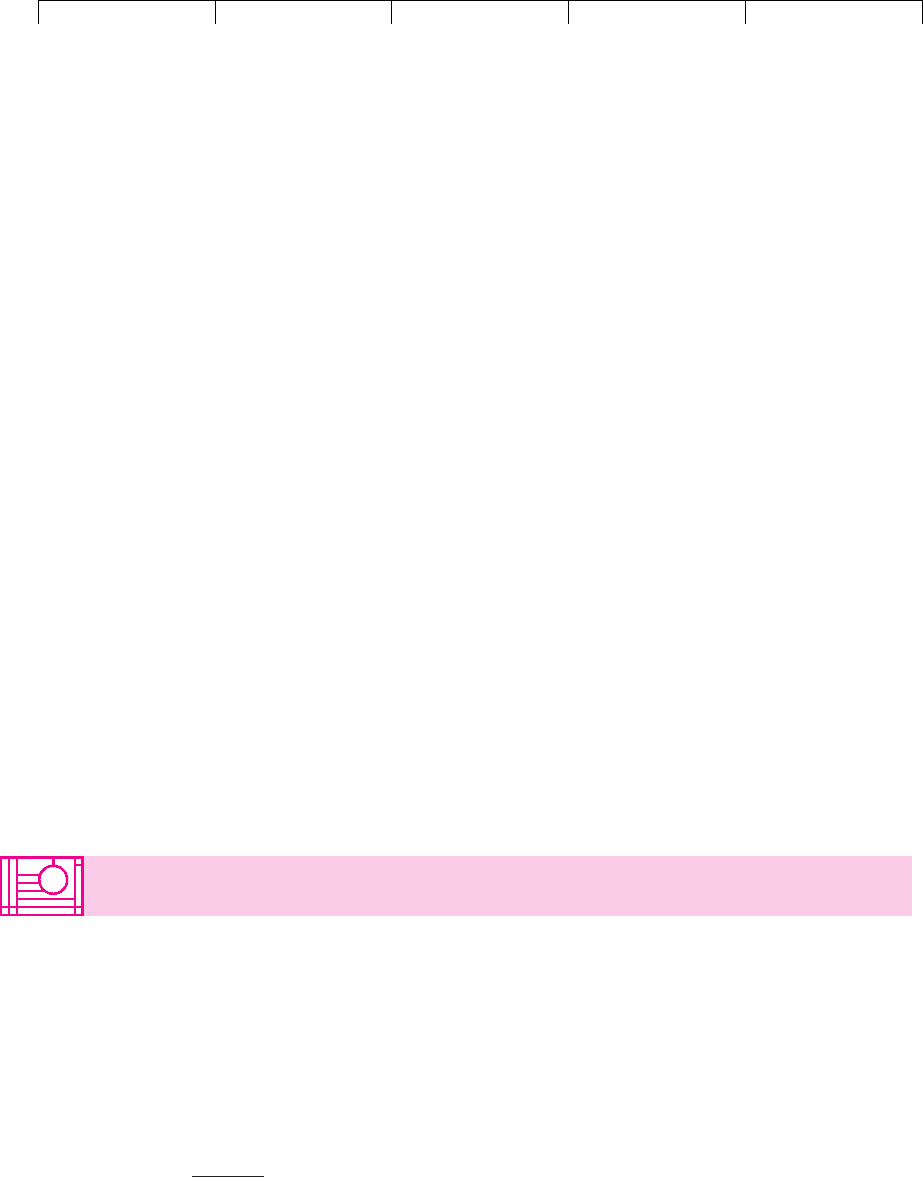
Brealey−Meyers:
Principles of Corporate
Finance, Seventh Edition
IX. Financial Planning and
Short−Term Management
32. Credit Management
© The McGraw−Hill
Companies, 2003
their accounts are large, if the customers need time to ascertain the quality of the
goods, and if the goods are not quickly resold.
To induce customers to pay before the final date, it is common to offer a cash dis-
count for prompt settlement. For example, pharmaceutical manufacturers com-
monly require payment within 30 days but may offer a 2 percent discount to cus-
tomers who pay within 10 days. These terms are referred to as “2/10, net 30.”
Cash discounts are often very large. For example, a customer who buys on terms
of 2/10, net 30 may decide to forgo the cash discount and pay on the thirtieth day. This
means that the customer obtains an extra 20 days’ credit but pays about 2 percent
more for the goods. This is equivalent to borrowing money at a rate of 44.6 percent
per annum.
3
Of course, any firm that delays payment beyond the due date gains a
cheaper loan but damages its reputation for creditworthiness.
You can think of the terms of sale as fixing both the price for the cash buyer and
the rate of interest charged for credit. For example, suppose that a firm reduces the
cash discount from 2 to 1 percent. That would represent an increase in the price for
the cash buyer of 1 percent but a reduction in the implicit rate of interest charged the
credit buyer from just over 2 percent per 20 days to just over 1 percent per 20 days.
For many items that are bought on a recurrent basis, it is inconvenient to require
separate payment for each delivery. A common solution is to pretend that all sales
during the month in fact occur at the end of the month (EOM). Thus goods may be
sold on terms of 8/10, EOM, net 60. This arrangement allows the customer a cash
discount of 8 percent if the bill is paid within 10 days of the end of the month; oth-
erwise, the full payment is due within 60 days of the invoice date.
4
When pur-
chases are subject to seasonal fluctuations, manufacturers often encourage cus-
tomers to take early delivery by allowing them to delay payment until the usual
order season. This practice is known as “season dating.”
910 PART IX
Financial Planning and Short-Term Management
3
The cash discount allows you to pay $98 rather than $100. If you do not take the discount, you get a
20-day loan, but you pay percent more for your goods. The number of 20-day periods in
a year is . A dollar invested for 18.25 periods at 2.04 percent per period grows to
, a 44.6 percent return on the original investment. If a customer is happy to borrow
at this rate, it’s a good bet that he or she is desperate for cash (or can’t work out compound interest).
For a discussion of this issue, see J. K. Smith, “Trade Credit and Information Asymmetry,” Journal of Fi-
nance 42 (September 1987), pp. 863–872.
4
Terms of 8/10, prox., net 60 would entitle the customer to a discount if the bill is paid within 10 days
of the end of the following (or “proximo”) month.
5
Commercial drafts are sometimes known by the more general term bills of exchange.
11.02042
18.25
$1.446
365/20 18.25
2/98 2.04
32.2 COMMERCIAL CREDIT INSTRUMENTS
The terms of sale define when payment is due but not the nature of the contract.
Repetitive sales to domestic customers are almost always made on open account and
involve only an implicit contract. There is simply a record in the seller’s books and
a receipt signed by the buyer.
If you want a clear commitment from the buyer, before you deliver the goods, you
can arrange a commercial draft.
5
This works as follows: You draw a draft ordering
payment by the customer and send this draft to the customer’s bank together with the
shipping documents. If immediate payment is required, the draft is termed a sight
draft; otherwise, it is known as a time draft. Depending on whether it is a sight or a time
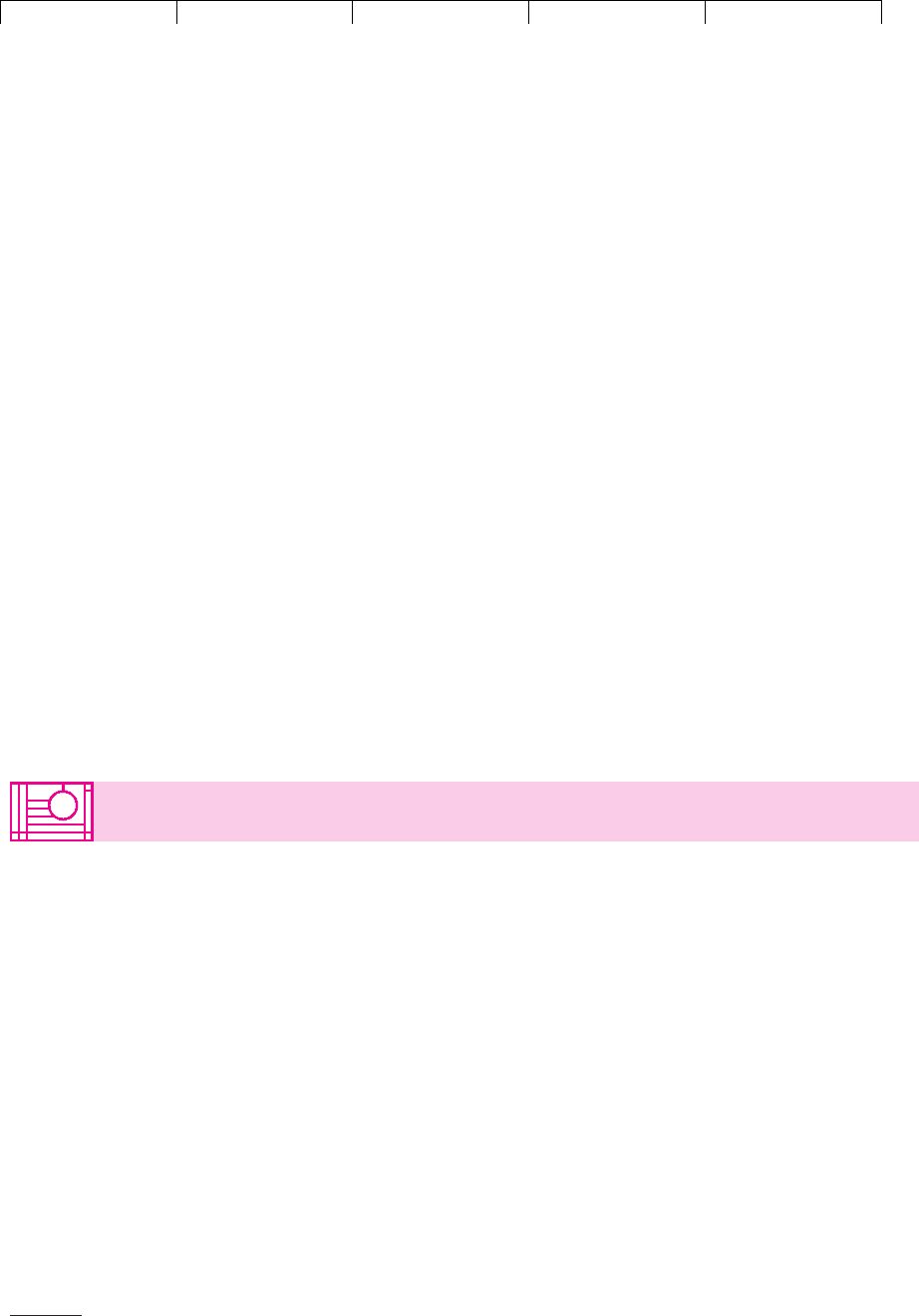
Brealey−Meyers:
Principles of Corporate
Finance, Seventh Edition
IX. Financial Planning and
Short−Term Management
32. Credit Management
© The McGraw−Hill
Companies, 2003
draft, the customer either pays up or acknowledges the debt by adding the word ac-
cepted and his or her signature. The bank then hands the shipping documents to the
customer and forwards the money or the trade acceptance to you, the seller.
6
You may
hold the trade acceptance to maturity or use it as security for a loan.
If your customer’s credit is for any reason suspect, you may ask the customer to
arrange for his or her bank to accept the time draft. In this case, the bank guarantees
the customer’s debt. These bankers’ acceptances are often used in overseas trade;
they have a higher standing and greater negotiability than trade acceptances.
If you are selling goods overseas, you may ask the customer to arrange for an ir-
revocable letter of credit. In this case the customer’s bank sends you a letter stating
that it has established a credit in your favor at a bank in the United States. You then
draw a draft on the customer’s bank and present it to your bank in the United
States together with the letter of credit and the shipping documents. The bank in
the United States arranges for this draft to be accepted or paid and forwards the
documents to the customer’s bank.
If you sell goods to a customer who proves unable to pay, you cannot get your
goods back. You simply become a general creditor of the company, in common
with other unfortunates. You can avoid this situation by making a conditional sale,
whereby title to the goods remains with the seller until full payment is made. The
conditional sale is common practice in Europe. In the United States it is used only
for goods that are bought on an installment basis. In this case, if the customer fails
to make the agreed number of payments, then the goods can be immediately re-
possessed by the seller.
CHAPTER 32
Credit Management 911
6
You often see the terms of sale defined as “SD-BL.” This means that the bank will hand over the bill of
lading in return for payment on a sight draft.
7
Price discrimination, and by implication credit discrimination, is prohibited by the Robinson-Patman Act.
32.3 CREDIT ANALYSIS
Firms are not allowed to discriminate between customers by charging them differ-
ent prices. Neither may they discriminate by offering the same prices but different
credit terms.
7
You can offer different terms of sale to different classes of buyers. You
can offer volume discounts, for example, or discounts to customers willing to ac-
cept long-term purchase contracts. But as a rule, if you have a customer of doubt-
ful standing, you should keep to your regular terms of sale and protect yourself by
restricting the volume of goods that the customer may buy on credit.
There are a number of ways to find out whether customers are likely to pay their
debts. For example, you are likely to have more confidence in those existing cus-
tomers that have paid promptly in the past. For new customers there are three broad
sources of information about their creditworthiness. You can seek the views of a spe-
cialist credit analyst, you can look at the information embedded in the firm’s security
prices, or you can use the firm’s financial statements to make your own assessment.
Specialist Credit Analysts The simplest way to assess a customer’s credit stand-
ing is to seek the views of a specialist in credit assessment. For example, in Chap-
ter 24 we described how bond rating agencies, such as Moody’s and Standard and
Poor’s, provide a useful guide to the riskiness of the firm’s bonds.

Brealey−Meyers:
Principles of Corporate
Finance, Seventh Edition
IX. Financial Planning and
Short−Term Management
32. Credit Management
© The McGraw−Hill
Companies, 2003
Bond ratings are usually available only for relatively large firms. However, you
can obtain information on many smaller companies from a credit agency. Dun and
Bradstreet is by far the largest of these agencies and its database contains reports
on more than 10 million companies.
Credit agencies usually report the experience that other firms have had with your
customer. Alternatively, you may be able to get this information by checking with a
credit bureau or by contacting the firms directly. You can also ask your bank to un-
dertake a credit check. It will contact the customer’s bank and ask for information on
the customer’s average balance, access to bank credit, and general reputation.
Security Prices In addition to checking with a credit agency or your bank, it may
make sense to check what everybody else in the financial community thinks about
your customer’s credit standing. Does that sound expensive? It isn’t if your cus-
tomer is a public company. For example, you can learn what other investors think
by comparing the yield on the firm’s bonds with the yields on those of other firms.
(Of course, the comparison should be between bonds of similar maturity, coupon,
etc.) You can also look at how the customer’s stock price has been behaving. A
sharp fall in stock price doesn’t mean that the company is in trouble, but it does
suggest that prospects are less bright than they were formerly.
In Chapter 24 we saw how information on security prices can be used to put a
figure on the chances of default. Companies have an incentive to exercise their
option to default when the value of their assets is less than the amount of their
debt. So, if you know how much the value of the firm’s assets may fluctuate, you
can estimate the probability that the asset value will fall below the default point.
In Chapter 24 we looked at an example of how one consulting firm, KMV, uses
this market-based approach to estimate default probabilities.
Financial Statements Security price data may not be available for many cus-
tomers, and in these cases you will need to rely on the customers’ financial state-
ments to make your own assessment of their credit standing. In Chapter 29 we saw
how managers calculate a few key financial ratios to measure the firm’s financial
strength. Firms that are highly leveraged, illiquid, and unprofitable generally don’t
make dependable customers.
If you have a large number of customers, it may be useful to combine different
financial indicators into a single measure of which companies or individuals are
most likely to default. For example, if you apply for a credit card or a bank loan,
you will be asked various questions about your financial position. The information
that you provide is then used to calculate an overall credit score. One widely used
system, designed by the consultancy firm Fair Isaacs, takes account of five factors:
(1) How promptly the applicant has paid in the past (35 percent of score); (2) how
much debt of each type is outstanding (30 percent of score); (3) the length of the ap-
plicant’s credit history (15 percent of score); (4) the number of credit cards and re-
cently opened credit accounts that the applicant has (10 percent of score); and
(5) the mix of regular credit cards, store cards, and margin accounts (10 percent of
score). Applicants who fail to make the grade on the score are likely to be refused
credit or subjected to more detailed analysis.
Suppose you want to devise a scoring system that will help you to decide
whether to extend credit to small businesses. You suspect that there is an above-
average probability that firms with a low return on assets and a low current ratio
912 PART IX
Financial Planning and Short-Term Management
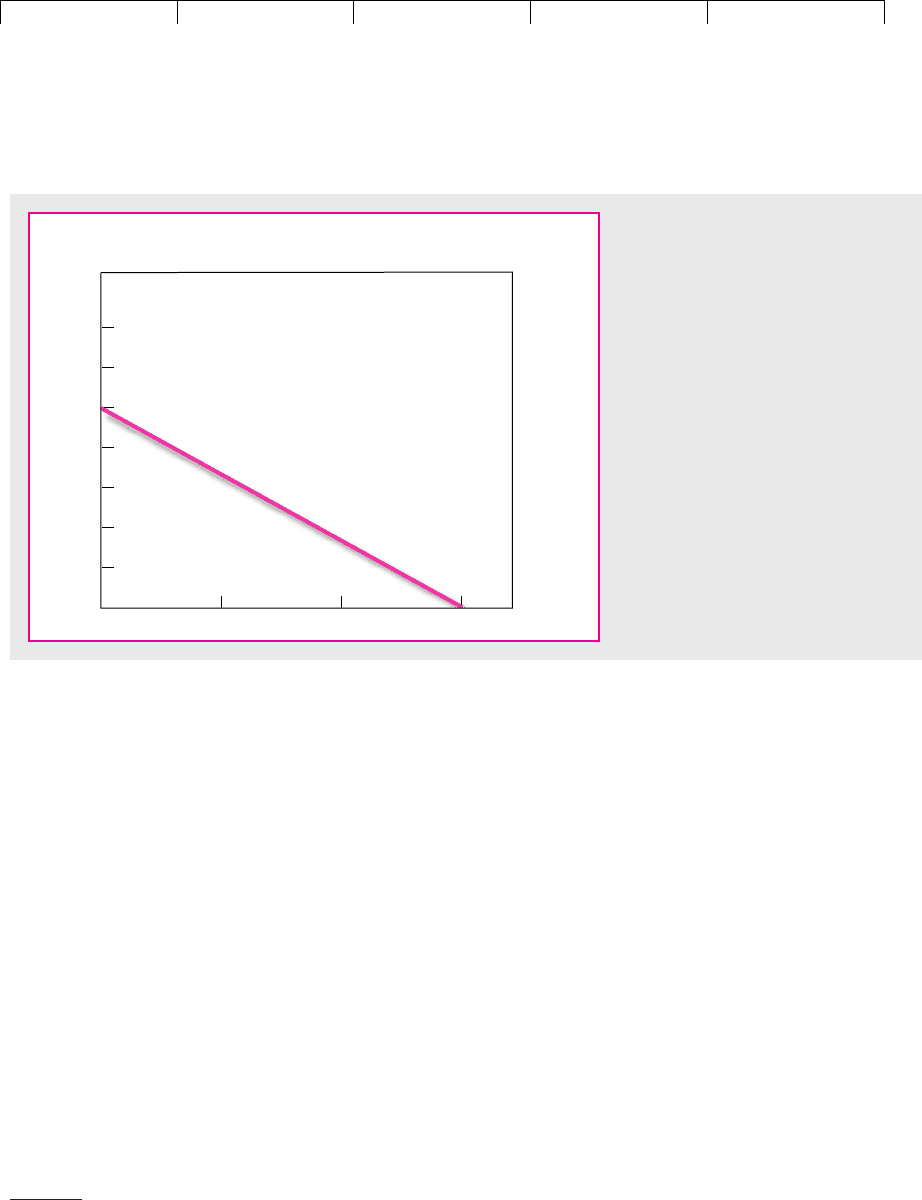
Brealey−Meyers:
Principles of Corporate
Finance, Seventh Edition
IX. Financial Planning and
Short−Term Management
32. Credit Management
© The McGraw−Hill
Companies, 2003
will default on their debts.
8
To test this, you take a sample of past loans and con-
struct a scatter diagram showing for each borrower the return on assets and the
current ratio (see Figure 32.1). Those businesses that repaid their loans are shown
by a blue x; the ones that defaulted are shown in burgundy. Now try to draw a
straight dividing line between the two groups. You can’t completely separate them,
but the line in our diagram keeps the two groups as far apart as possible. (Note that
there are only three blue x’s below the line and three burgundy ’s above it.) This
line tells us that if you wish to discriminate between the good and the bad risks, you
should give 10 times as much weight to the current ratio as you give to return on
assets. The index of creditworthiness is
You minimize the degree of misclassification if you predict that applicants with
Z scores over 15 will pay their debts and that those with Z scores below 15 will
not pay.
9
In practice you do not need to consider only two variables, nor do you need to
estimate the equation by eye. Multiple-discriminant analysis (MDA) is a straightfor-
ward statistical technique for calculating how much weight to put on each variable
to separate the creditworthy sheep from the impecunious goats.
10
Index of creditworthiness Z return on assets, percent 10 1current ratio2
CHAPTER 32 Credit Management 913
0
Return on
assets, percent
21
18
15
3
6
9
12
0.5 1.0 1.5
Current
ratio
x
x
x
x
x
x
x
x
x
x
x
x
x
x
x
x
+
+
+
+
+
+
+
+
+
+
+
+
FIGURE 32.1
The black x’s represent a hypothetical
group of firms that subsequently
repaid their loans; the burgundy ’s
represent those that defaulted. The
sloping line discriminates between the
two groups on the basis of return on
assets and current ratio. The line
represents the equation
Z return on assets
10(current ratio)
15
Firms that plot above the line have
Z scores greater than 15.
8
The current ratio is the ratio of current assets to current liabilities. It is commonly used as a measure
of the company’s ability to lay its hands on cash. See Chapter 29.
9
The quantity 15 is an arbitrary constant. We could just as well have used 150, in which case the Z score is
10
MDA is not the only statistical technique that you can use for this purpose. Probit and logit are two
other potentially useful techniques. These estimate the probability of some event (e.g., default) as a
function of observable attributes.
Z 101return on assets, percent2 1001current ratio2
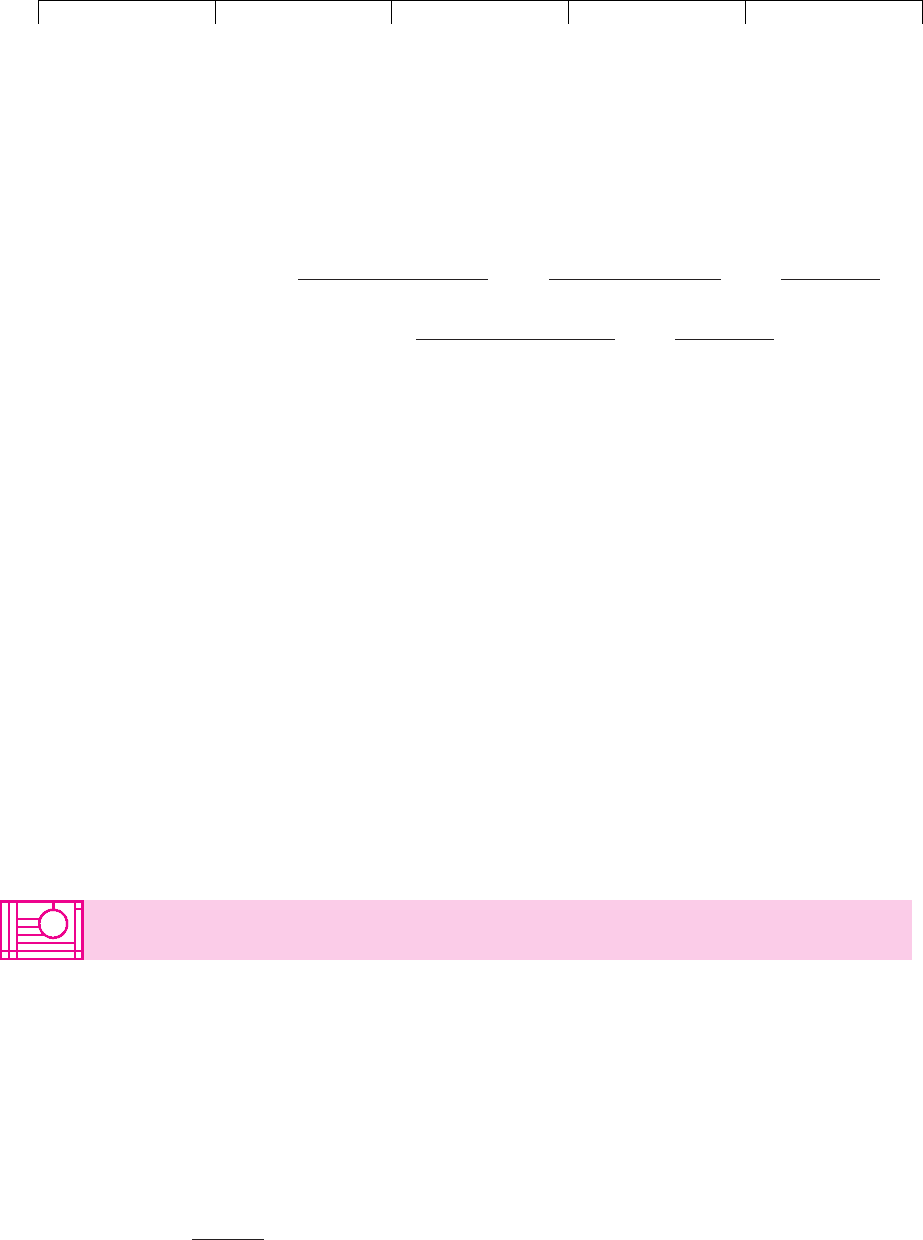
Brealey−Meyers:
Principles of Corporate
Finance, Seventh Edition
IX. Financial Planning and
Short−Term Management
32. Credit Management
© The McGraw−Hill
Companies, 2003
Edward Altman has used discriminant analysis to come up with the following
index of creditworthiness:
11
Those companies with a Z-score of less than 1.20 were predicted to go bankrupt.
Companies with Z-scores between 1.20 and 2.90 were hovering in the grey area be-
tween decline and recovery.
Updated and refined versions of Altman’s Z-score model are regularly used by
banks and industrial companies. We wish we could show you one of these recent
versions, but they are all top secret. A company with a superior method for identi-
fying good and bad borrowers has a significant leg up on the competition.
12
Credit scoring systems should carry a health warning. When you construct a
risk index, it is tempting to experiment with many different combinations of vari-
ables until you find the equation that would have worked best in the past. Unfor-
tunately, if you “mine” the data in this way, you are likely to find that the system
works less well in the future than it did previously. If you are misled by the past
successes into placing too much faith in your model, you may refuse credit to a
number of potentially good customers. The profits that you lose by turning away
these customers could more than offset the gains that you make from avoiding a
few bad eggs. As a result, you could be worse off than if you had pretended that
you could not tell one customer from another and extended credit to all of them.
Does this mean that you should not use credit scoring systems? Not a bit. It sim-
ply implies that it is not sufficient to have a good credit scoring system; you also
need to know how much to rely on it. That is the topic of the next section.
.42
1shareholders’ equity2
total liabilities
1.0
sales
total assets
Z .72
1net working capital2
total assets
.85
1retained earnings2
total assets
3.1
1EBIT2
total assets
914 PART IX Financial Planning and Short-Term Management
11
EBIT is earnings before interest and taxes. Z-score models for predicting bankruptcy were originally
developed in E. I. Altman, “Financial Ratios, Discriminant Analysis and the Prediction of Corporate
Bankruptcy,” Journal of Finance 23 (September 1968), pp. 589–609. The equation cited here comes from
E. I. Altman, Corporate Financial Distress, John Wiley, New York, 1983.
12
When a British bank laid off a number of employees, one unhappy staff member decided that the best
way to retaliate was to leak details of the bank’s credit scoring system to the press. See V. Orvice,
“Would You Get a Loan?” Daily Mail, March 16, 1994, p. 29.
32.4 THE CREDIT DECISION
Let us suppose that you have taken the first three steps toward an effective credit
operation. In other words, you have fixed your terms of sale; you have decided on
the contract that customers must sign, and you have established a procedure for
estimating the probability that they will pay up. Your next step is to work out
which of your customers should be offered credit.
If there is no possibility of repeat orders, the decision is relatively simple.
Figure 32.2 summarizes your choice. On one hand, you can refuse credit. In this
case you make neither a profit nor a loss. The alternative is to offer credit. Sup-
pose that the probability that the customer will pay up is p. If the customer does
pay, you receive additional revenues (REV) and you incur additional costs; your
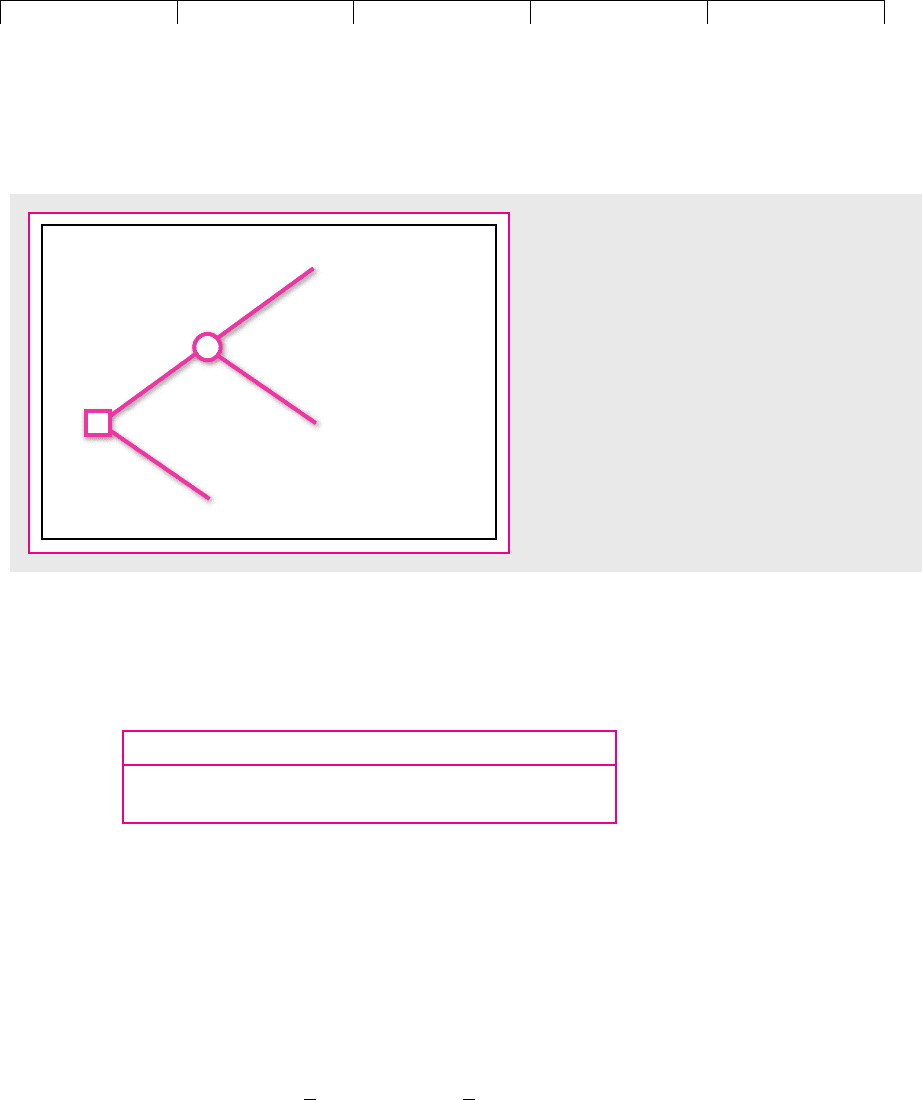
Brealey−Meyers:
Principles of Corporate
Finance, Seventh Edition
IX. Financial Planning and
Short−Term Management
32. Credit Management
© The McGraw−Hill
Companies, 2003
net gain is the present value of . Unfortunately, you can’t be certain
that the customer will pay; there is a probability of default. Default means
you receive nothing and incur the additional costs. The expected profit from each
course of action is therefore as follows:
11 p2
REV COST
CHAPTER 32
Credit Management 915
0
–COST
Refuse credit
Offer credit
Customer defaults (1 –
p
)
Customer pays (
p
)
REV–COST
FIGURE 32.2
If you refuse credit, you make neither profit nor
loss. If you offer credit, there is a probability p
that the customer will pay and you will make
REV COST; there is a probability (1 p) that the
customer will default and you will lose COST.
Expected Profit
Refuse credit 0
Grant credit pPV(REV COST) (1 p)PV(COST)
You should grant credit if the expected profit from doing so is greater than the ex-
pected profit from refusing.
Consider, for example, the case of the Cast Iron Company. On each nondelin-
quent sale Cast Iron receives revenues with a present value of $1,200 and incurs
costs with a value of $1,000. Therefore the company’s expected profit if it offers
credit is
If the probability of collection is 5/6, Cast Iron can expect to break even:
Therefore Cast Iron’s policy should be to grant credit whenever the chances of col-
lection are better than 5 out of 6.
When to Stop Looking for Clues
We told you earlier where to start looking for clues about a customer’s creditwor-
thiness, but we never said anything about when to stop. Now we can work out how
your profits would be affected by more detailed credit analysis.
Suppose that Cast Iron Company’s credit department undertakes a study to de-
termine which customers are most likely to default. It appears that 95 percent of its
customers have been prompt payers and 5 percent have been slow payers. However,
Expected profit
5
6
200 a1
5
6
b 1, 000 0
pPV1REV COST2 11 p2PV1COST2 p 200 11 p2 1,000
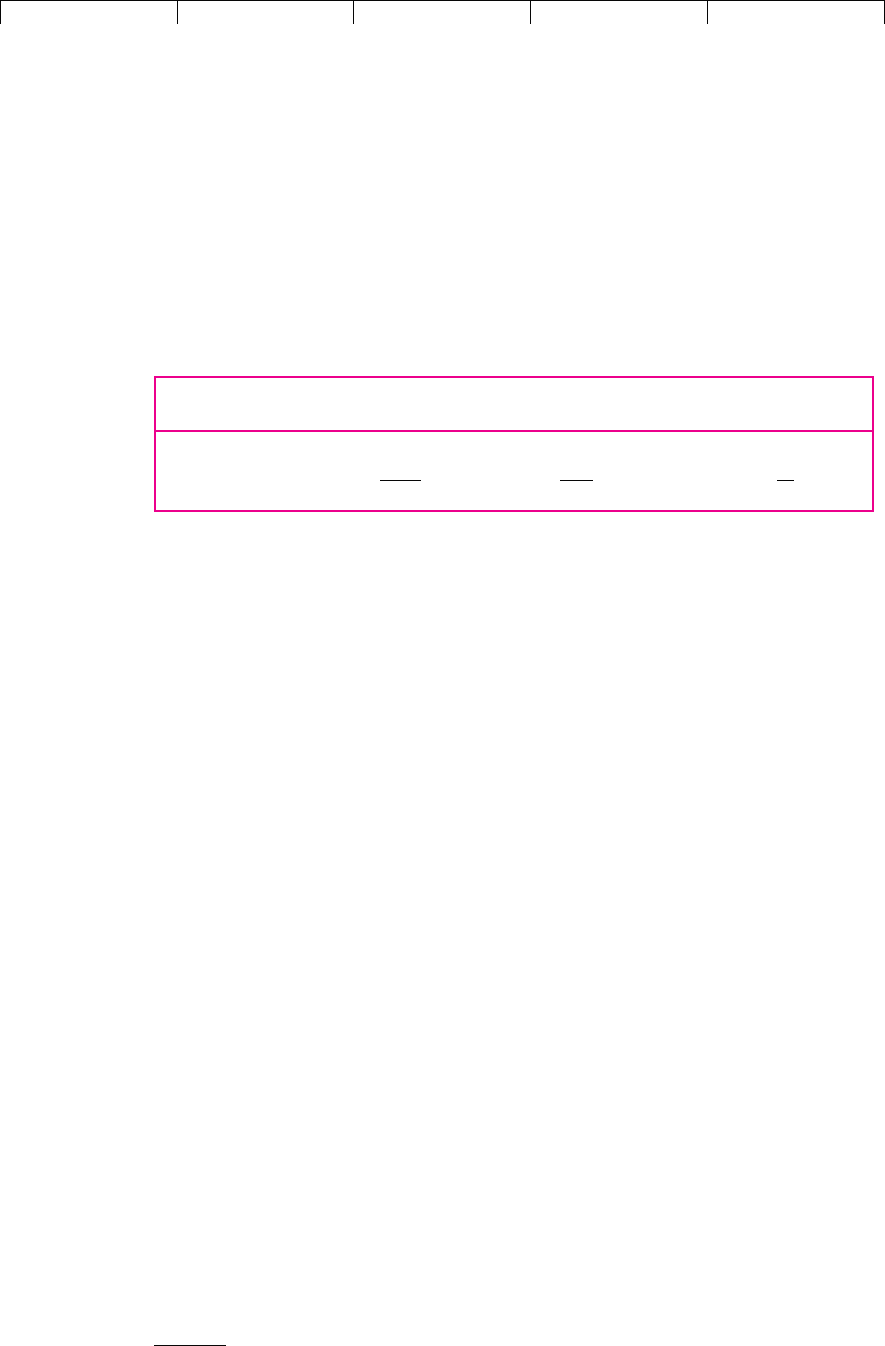
Brealey−Meyers:
Principles of Corporate
Finance, Seventh Edition
IX. Financial Planning and
Short−Term Management
32. Credit Management
© The McGraw−Hill
Companies, 2003
customers with a record of slow payment are much more likely to default on the next
order than those with a record of prompt payment. On the average 20 percent of the
slow payers subsequently default, but only 2 percent of the prompt payers do so.
Suppose Cast Iron reviews a sample of 1,000 customers, none of whom has de-
faulted yet. Of these, 950 have a record of prompt payment, and 50 have a record
of slow payment. On the basis of past experience Cast Iron should expect 19 of the
prompt payers to default in the future and 10 of the slow payers to do so:
916 PART IX
Financial Planning and Short-Term Management
Number of Probability of Expected Number
Category Customers Default of Defaults
Prompt payers 950 .02 19
Slow payers 50 .20 10
All customers 1,000 .029 29
Now the credit manager must make a decision: Should the company refuse to give
any more credit to customers that have been slow payers in the past?
If you are aware that a customer has been a slow payer, the answer is clearly yes.
Every sale to a slow payer has only an 80 percent chance of payment . Sell-
ing to a slow payer, therefore, gives an expected loss of $40:
But suppose that it costs $10 to search through Cast Iron’s records to determine
whether a customer has been a prompt or slow payer. Is it worth doing so? The ex-
pected payoff to such a check is
In this case checking isn’t worth it. You are paying $10 to avoid a $40 loss 5 percent
of the time. But suppose that a customer orders 10 units at once. Then checking is
worthwhile because you are paying $10 to avoid a $400 loss 5 percent of the time:
The credit manager therefore decides to check customers’ past payment records
only on orders of more than five units. You can verify that a credit check on a five-
unit order just pays for itself.
Our illustration is simplistic, but you have probably grasped the message: You
don’t want to subject each order to the same credit analysis. You want to concen-
trate your efforts on the large and doubtful orders.
Credit Decisions with Repeat Orders
So far we have ignored the possibility of repeat orders. But one of the reasons for of-
fering credit today is that you may get yourself a good, regular customer by doing so.
Figure 32.3 illustrates the problem.
13
Cast Iron has been asked to extend credit
to a new customer. You can find little information on the firm, and you believe that
Expected payoff to credit check 1.05 4002 10 $10
1.05 402 10 $8
Expected payoff
to credit check
probability of identifying a slow payer
gain from not extending credit
cost of credit check
.812002 .211,0002 $40
Expected profit pPV1REV COST2 11 p2PV1COST2
1p .82
(
)
13
Our example is adapted from H. Bierman, Jr., and W. H. Hausman, “The Credit Granting Decision,”
Management Science 16 (April 1970), pp. B519–B532.
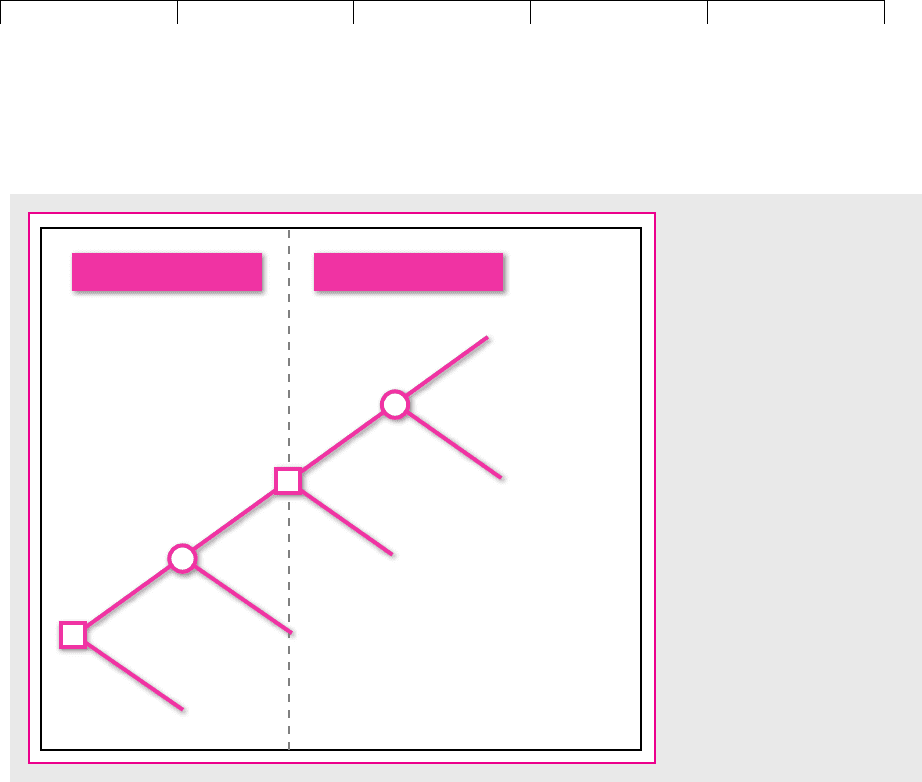
Brealey−Meyers:
Principles of Corporate
Finance, Seventh Edition
IX. Financial Planning and
Short−Term Management
32. Credit Management
© The McGraw−Hill
Companies, 2003
the probability of payment is no better than .8. If you grant credit, the expected
profit on this customer’s order is
You decide to refuse credit.
This is the correct decision if there is no chance of a repeat order. But look again
at the decision tree in Figure 32.3. If the customer does pay up, there will be a re-
order next year. Because the customer has paid once, you can be 95 percent sure
that he or she will pay again. For this reason any repeat order is very profitable.
Now you can reexamine today’s credit decision. If you grant credit today, you re-
ceive the expected profit on the initial order plus the possible opportunity to extend
credit next year:
40 .80 PV11402
PV1next year’s expected profit on repeat order2
probability of payment and repeat order
Total expected profit expected profit on initial order
1.95 2002 1.05 1,
0002 $140
PV1COST
2
2
Next year’s expected profit on repeat order p
2
PV1REV
2
COST
2
2 11 p
2
2
1.8 2002 1.2 1,0002 $40
11 p
1
2 PV1COST2
Expected profit on initial order p
1
PV1REV COST2
CHAPTER 32
Credit Management 917
Period 1 Period 2
0
–COST
1
Refuse credit
Refuse credit
Offer credit
Offer credit
Customer pays
p
2
= .95
Customer defaults
(1 -
p
2
) = .05
Customer defaults
(1 –
p
1
) = .2
Customer pays
p
1
= .8
0
–COST
2
REV
1
– COST
1
REV
2
–COST
2
FIGURE 32.3
In this example there is only a
.8 probability that your
customer will pay in period 1;
but if payment is made, there
will be another order in
period 2. The probability that
the customer will pay for the
second order is .95. The possi-
bility of this good repeat order
more than compensates for the
expected loss in period 1.

Brealey−Meyers:
Principles of Corporate
Finance, Seventh Edition
IX. Financial Planning and
Short−Term Management
32. Credit Management
© The McGraw−Hill
Companies, 2003
At any reasonable discount rate, you ought to extend credit. For example, if the dis-
count rate is 20 percent,
In this example you should grant credit even though you expect to take a loss on
the order. The expected loss is more than outweighed by the possibility that you
will secure a reliable and regular customer.
Some General Principles
Sometimes the credit manager faces clear-cut choices. In such circumstances it may
be possible to estimate fairly precisely the consequences of a more liberal or a more
stringent credit policy. But real-life situations are generally far more complex than
our simple examples. Customers are not all good or all bad. Many of them pay con-
sistently late; you get your money, but it costs more to collect and you lose a few
months’ interest. Then there is the question of risk: You may be able to measure the
revenues and costs, but at what rate do you discount them?
Like almost all financial decisions, credit allocation involves a strong dose of
judgment. Our examples are intended as reminders of the issues involved rather
than as cookbook formulas. Here are the basic things to remember.
1. Maximize profit. As credit manager, you should not focus on minimizing the
number of bad accounts; your job is to maximize expected profit. You must
face up to the following facts: The best that can happen is that the customer
pays promptly; the worst is default. In the best case, the firm receives the
full additional revenues from the sale less the additional costs; in the worst,
it receives nothing and loses the costs. You must weigh the chances of these
alternative outcomes. If the margin of profit is high, you are justified in a
liberal credit policy; if it is low, you cannot afford many bad debts.
2. Concentrate on the dangerous accounts. You should not expend the same effort
on analyzing all credit applications. If an application is small or clear-cut,
your decision should be largely routine; if it is large or doubtful, you may
do better to move straight to a detailed credit appraisal. Most credit
managers don’t make credit decisions on an order-by-order basis. Instead,
they set a credit limit for each customer. The sales representative is required
to refer the order for approval only if the customer exceeds this limit.
3. Look beyond the immediate order. The credit decision is a dynamic problem.
You cannot look only at the present. Sometimes it may be worth accepting a
relatively poor risk as long as there is a likelihood that the customer will
become a regular and reliable buyer. New businesses must, therefore, be
prepared to incur more bad debts than established businesses. This is part
of the cost of building up a good customer list.
Total expected profit 1present value2 40
.811402
1.2
$53.33
918 PART IX Financial Planning and Short-Term Management
32.5 COLLECTION POLICY
It would be nice if all customers paid their bills by the due date. But they don’t—
and since you may also occasionally “stretch” your payables, you can’t altogether
blame them.
